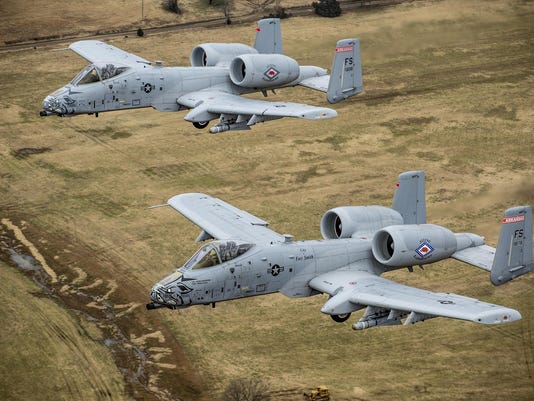
The best way to resolve the A-10 retirement debate is to satisfy both sides with a solution that eliminates the operational and economic arguments driving it.
The primary vocal critics of the Air Force decision to retire the A-10 close-support aircraft are Sen. John McCain, R-Ariz., Sen. Kelly Ayotte, R-N.H., and freshman Rep. Martha McSally, R-Ariz. All three have strong ties to the A-10. Davis-Monthan Air Force Base in Tucson, Arizona, is home to the largest A-10 base. Closure of the base would have serious economic impact. Ayotte’s husband is a former A-10 pilot. McSally flew A-10s in the Air Force.
The Air Force has presented strong operational arguments defending the retirement of the A-10: Other aircraft perform the A-10’s close-support mission today with the same effectiveness, and more survivability. The A-10 can only perform close support whereas other aircraft can perform close support and other missions, thus offering more value in a smaller Air Force. And with today’s precision weapons and automation, pilots can train for both close support and other roles without sacrificing effectiveness.
Former A-10 pilots argue from an emotional point of view citing personal experiences. With the strong support of McCain, Ayotte and McSally, they have organized a support group and congressional contingent advocating retention.
But they have been unable to shoot down the rationale the Air Force puts forth in defense of retiring the A-10. Their arguments are laden with shrill, emotional points of view, but are mostly anecdotal and unpersuasive when measured against objective, logical reasoning.
Moreover, this impasse is having adverse impacts on Air Force plans to field the F-35. To continue to operate the fleet of A-10s, it is necessary to forgo building up the maintenance force necessary to field the F-35. This slows the development of proficiency in Air Force F-35 pilots and, consequently, the operational readiness and competence of F-35 squadrons.
It also forces the Air Force to alter its rhythm to balance training, operational readiness and deployment commitments, creating a problem for combatant commanders who depend on having the F-35 in overseas theaters.
But there is a way to resolve this annual fight between the Air Force and A-10 advocates in the Army and Congress.
The Army likes the A-10 not just because of its attack capabilities but even more so because it is totally dedicated to close support of Army forces. The Army fears that without the A-10, and even though other aircraft can perform close support satisfactorily, the Air Force will not be there when needed.
To ensure the Army can depend on Air Force close support, the Air Force and Army should agree to negotiate a formal compact to team Air Force squadrons and controllers with Army brigades. Squadrons of F-16s, B-52s, B-1s and, soon, F-35s would be required to allocate a portion of their training to exercise and deploy with specific Army units. This teaming concept is not new but has not been enforced to the extent of this proposal.
An added benefit would be the close, symbiotic relationship that would bond the units, boosting team esprit and combat effectiveness, potentially more than exists today with the A-10.
To satisfy economic issues motivating opponents, the Air Force needs to ensure that Davis-Monthan — the A-10’s master base with more than 80 A-10s and 4,000 jobs — remains a major Air Force installation and economic engine in Arizona. It must, therefore, replace the A-10s with another operational mission at the base and at smaller Air National Guard A-10 locations.
Because the Air Force will likely retain its existing bombers, it will need at least one other big base with large ramps, a long runway and modern facilities for its new stealth bomber, the Long Range Strike Bomber. Dispersal of bombers, particularly nuclear bombers, is also necessary for nuclear deterrence to work. There is no bomber base in the southwest. Davis-Monthan would be an excellent choice.
Davis-Monthan could also be a home for the KC-46A tanker, or the upcoming T-X trainer. Since Luke Air Force Base near Phoenix is already a new F-35 training base, Arizona would then retain its two large bases with new, important Air Force missions, thus mitigating economic concerns.
For smaller Air National Guard A-10 units, the Air Force can find new missions as it does routinely during drawdowns and equipment changes.
The standoff between the Air Force and congressional opponents has become debilitating. Both sides need to work together for an amicable solution. Teaming Army and Air Force units for close support and replacing A-10s with new aircraft at Davis-Monthan are win-win for both.
Retired Gen. John Michael Loh is a former Air Force vice chief of staff and former commander of Air Combat Command.

